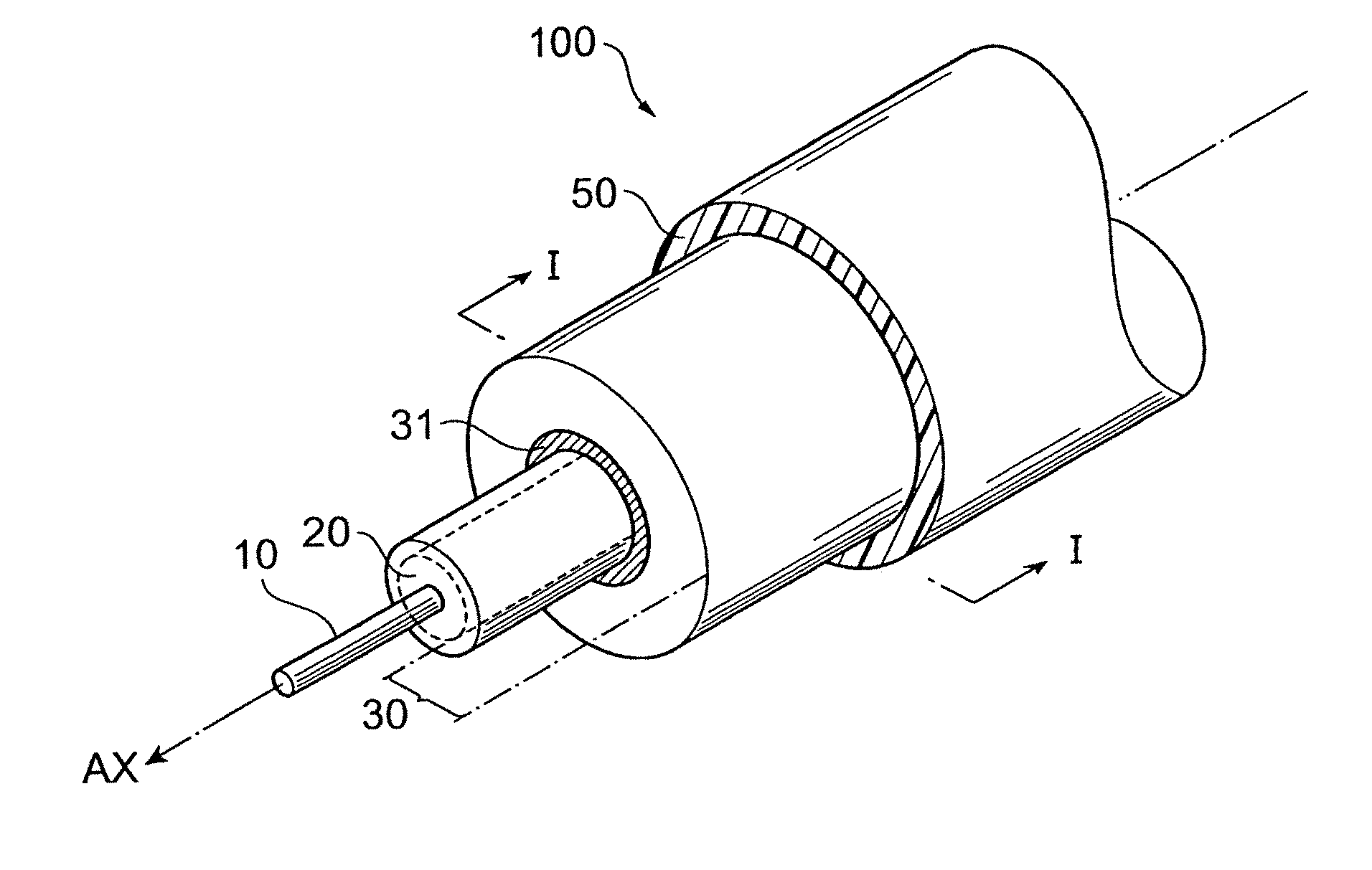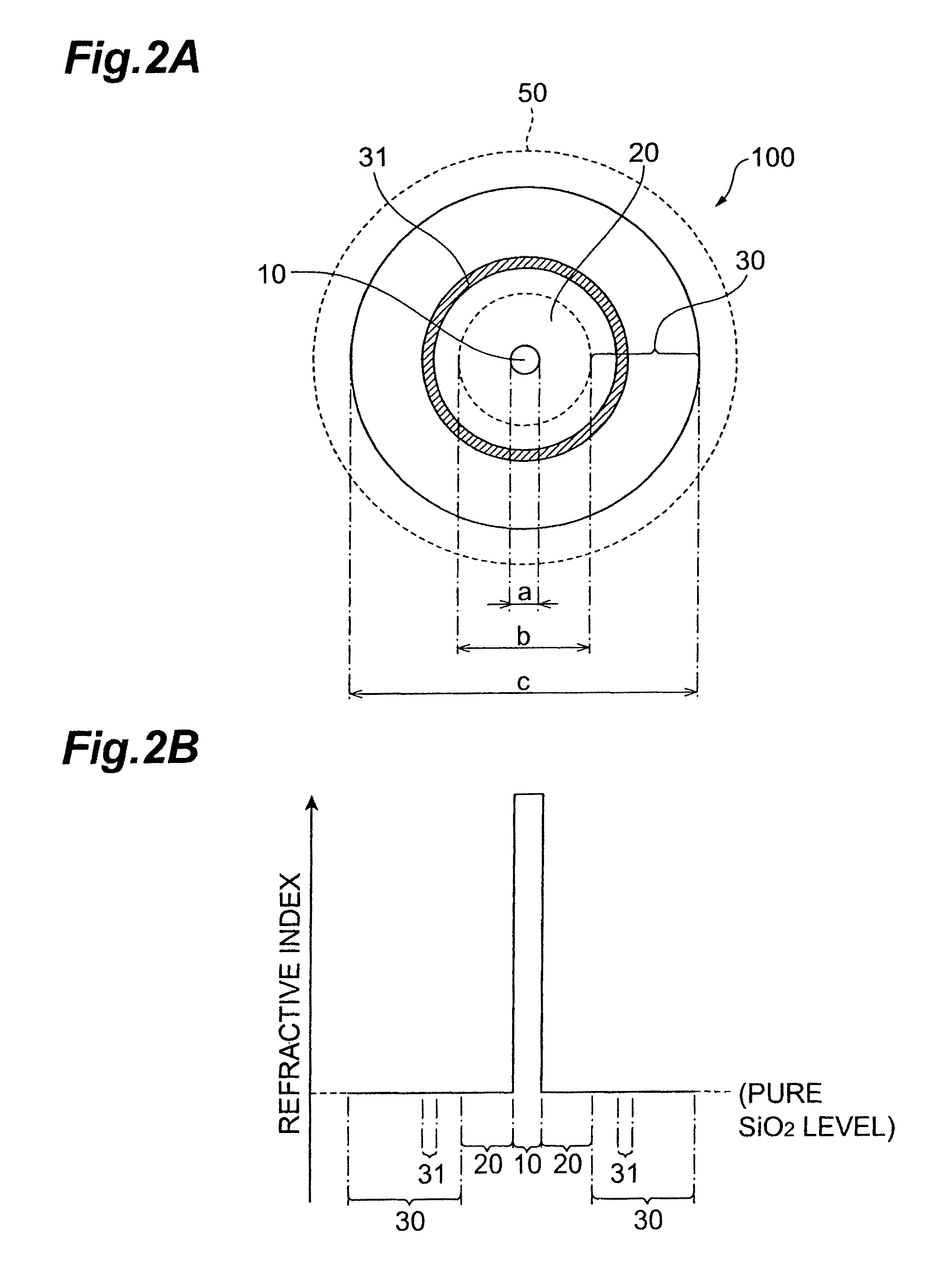Optical fiber
a technology of optical fiber and fiber, applied in the field of optical fiber, can solve the problems of large propagation loss, inability to achieve both propagation loss prevention and low propagation loss, and inability to achieve low propagation loss, reduce light quantity, and prevent the effect of resin coating combustion
- Summary
- Abstract
- Description
- Claims
- Application Information
AI Technical Summary
Benefits of technology
Problems solved by technology
Method used
Image
Examples
first embodiment
[0028]FIG. 1 is a perspective view showing the schematic structure of a first embodiment of an optical fiber according to the present invention. FIG. 2A shows the cross-sectional structure of the optical fiber according to the first embodiment orthogonal to the optical axis AX, and FIG. 2B is the refractive index profile thereof. The schematic structure of the optical fiber shown in FIG. 1 is a schematic structure common to the second through fourth embodiments explained below.
[0029]As shown in FIG. 1, the optical fiber 100 according to the first embodiment comprises a core region 10 extending along the optical axis AX, a cladding region provided on an outer periphery of the core region 10, and a resin coating (UV (ultraviolet) curable resin) 50 provided on an outer periphery of the cladding region. The cladding region is constituted by an optical cladding 20 provided directly on an outer periphery of the core region 10, and a physical cladding 30 provided on an outer periphery of t...
second embodiment
[0037]FIGS. 4A to 4D show the schematic structure of a second embodiment of an optical fiber according to the present invention. The second embodiment performs leaked light deflection control by confining leaked light within a region on the inside of the leakage reduction portion. FIG. 4A is a cross-sectional view showing the structure of the optical fiber 200 according to the second embodiment, and is equivalent to a cross-section along line I-I in FIG. 1. FIG. 4B is a refractive index profile of the optical fiber 200, and shows first means for achieving leaked light deflection control in the second embodiment. FIG. 4C is an enlarged view of the portion B in FIG. 4A, and shows second means for achieving leaked light deflection control in the second embodiment. FIG. 4D is an enlarged view of the portion B in FIG. 4A, and shows third means for achieving leaked light deflection control in the second embodiment.
[0038]The optical fiber 200 according to the second embodiment comprises a ...
third embodiment
[0048]FIGS. 5A to 5C show the schematic structure of a third embodiment of an optical fiber according to the present invention. In the third embodiment, leaked light deflection control is performed by causing propagation, in the leakage reduction portion, of the leaked light which has arrived from the core region. FIG. 5A is a cross-sectional view showing the structure of the optical fiber 300 according to the third embodiment, and is equivalent to the cross-section along line I-I in FIG. 1. FIG. 5B is a refractive index profile of the optical fiber 300, and shows first means for achieving leaked light deflection control in the third embodiment. FIG. 5C is an enlarged view of the portion C in FIG. 5A, and shows second means for achieving leaked light deflection control in the third embodiment.
[0049]The optical fiber 300 according to the third embodiment comprises a core region extending along the optical axis AX, a cladding region provided on an outer periphery of the core region 10...
PUM
 Login to View More
Login to View More Abstract
Description
Claims
Application Information
 Login to View More
Login to View More - R&D
- Intellectual Property
- Life Sciences
- Materials
- Tech Scout
- Unparalleled Data Quality
- Higher Quality Content
- 60% Fewer Hallucinations
Browse by: Latest US Patents, China's latest patents, Technical Efficacy Thesaurus, Application Domain, Technology Topic, Popular Technical Reports.
© 2025 PatSnap. All rights reserved.Legal|Privacy policy|Modern Slavery Act Transparency Statement|Sitemap|About US| Contact US: help@patsnap.com



